#Green Hydrogen in India
Explore tagged Tumblr posts
Text
Unlocking Potential of Green Hydrogen and Ammonia in India’s Industrial Sector

India is rapidly moving towards adopting sustainable energy solutions, and green hydrogen is one of the key players in this transformation. This is probably because its clean energy source can revolutionize a range of sectors and industries where carbon reduction is a major challenge. Green hydrogen and high purity green ammonia mark a landmark shift in India's pursuit of a green energy future. Let's explore how green hydrogen and ammonia are unlocking new possibilities for clean energy solutions and advancing India’s industrial sector.
What is Green Hydrogen?
Green hydrogen is hydrogen produced through the process of electrolysis, using renewable energy sources such as solar or wind power. This process splits water into hydrogen and oxygen, without releasing any harmful pollutants or carbon emissions. Unlike conventional hydrogen production, which relies on fossil fuels, green hydrogen offers a truly sustainable alternative. With India’s growing commitment to reducing carbon emissions and adopting cleaner energy sources, green hydrogen is going to be an integral part of the country’s energy strategy.
India's industrial sector is one of the biggest contributors to carbon emissions, which makes the shift towards clean energy crucial. The Indian government has seriously identified the potential of green hydrogen and is focusing on creating infrastructure and policies to support its large-scale usage.
The Role of High Purity Green Ammonia
High purity green ammonia is also an important technology of green hydrogen. Ammonia is widely used in industries, the maximum of their contributions in agriculture for fertilizers, but its traditional production process is highly carbon-intensive. By using green hydrogen to produce high purity green ammonia, India can significantly reduce the carbon emissions associated with this process.
Green hydrogen and renewable energy produce high-purity green ammonia that is much cleaner than conventional ammonia. This shift to green ammonia is not just beneficial for the environment but also for India’s economy, as it will reduce dependency on imported fossil fuels and support local agricultural industries of India by providing cleaner alternatives to chemical fertilizers.
Green Hydrogen’s Impact on India’s Industrial Sector
India’s industrial sector is currently responsible for a large portion of the country's carbon emissions. Green hydrogen could thus make a major shift in the environmental profile of industries such as steel, cement, and chemicals. The production of most of these companies largely depends on fossil fuels, but green hydrogen could provide them as a clean alternative, helping companies lower their carbon footprint.
In particular, green hydrogen can be used in processes such as steel production, which is one of the most energy-consuming industries. Replacing coal with green hydrogen as a reducing agent in steel-making could successfully reduce millions of tons of carbon emissions. Additionally, green hydrogen can further be used in fuel cells for heavy transportation, such as trucks and trains, further contributing to the country’s transition to a clean energy future.
India’s Commitment to Green Hydrogen
India has ambitious goals for green energy adoption, and green hydrogen plays a central player in these plans. The Indian government has already announced several initiatives to boost the production of green hydrogen. By 2030, it aims to manufacture green hydrogen in the amount of 5 million metric tons annually and also create a capacity for hydrogen production of 15-20 GW.
To achieve these targets, India is focusing on expanding the green hydrogen infrastructure and investing in technology development. By scaling up production and creating fresh markets for green hydrogen, India can reduce its dependence on fossil fuels, lower its carbon emissions, and move India closer to its clean energy goals.
KP Group's Role in Green Hydrogen and Ammonia Projects
KP Group is a pioneer in the green hydrogen revolution in India. The company’s KPI Green Hydrogen and Ammonia project aims to deliver large-scale green hydrogen and high purity green ammonia solutions that will support India’s industrial transition. With a strong focus on sustainable energy, KP Group is dedicated to producing green hydrogen and ammonia using renewable energy, by contributing significantly to carbon reduction efforts.
The KPI Green Hydrogen and Ammonia project focuses on developing the infrastructure and technologies needed to produce green hydrogen and high purity green ammonia in large quantities. This project will not only provide a clean energy solution for India’s industrial sector but also help in achieving the ambitious climate goals of the country.
Benefits of Green Hydrogen and Ammonia for India
Reduced Carbon Emissions: One of the major advantages of green hydrogen and ammonia is that they significantly reduce carbon emissions. These technologies offer a cleaner, more sustainable alternative to traditional fossil fuels.
Economic Growth: The green energy sector, including green hydrogen and high purity green ammonia, has the potential to drive economic growth by providing employment, reducing dependency on fossil fuel imports, and promoting new industries.
Energy Security: By adopting green hydrogen production, India can reduce its dependence on foreign energy supplies and secure a more sustainable and self-sufficient energy future.
Sustainable Agriculture: High purity green ammonia, produced from green hydrogen, provides an eco-friendly alternative to traditional ammonia, which is essential for the agricultural sector.
The Future of Green Hydrogen and Ammonia in India
As India works towards achieving its green energy goals, the adoption of green hydrogen and ammonia will play an important role in redefining the industrial landscape. With the support of government policies, technological advancements, and projects like the ones initiated by KP Group, India will indeed become one of the global leaders in the green hydrogen and ammonia market.
India's industrial sector is ready for a change, and green hydrogen is the key to unlocking this potential. By focusing on clean energy solutions and reducing carbon emissions, India can create a more sustainable and prosperous future for generations to come. For more details or inquiries about green hydrogen and high purity green ammonia projects, feel free to reach out to us. We are here to assist you with all your sustainable energy solutions.
#Green Hydrogen#High Purity Green Ammonia#Clean Energy#Green Energy#Green Hydrogen in India#Reduced Carbon Emissions#Green Hydrogen Projects#Renewable Energy India#Sustainable Energy Solutions
0 notes
Text
Pioneering the Future: Green Hydrogen Companies in India
Green hydrogen companies in India are at the forefront of the country’s transition to clean energy, driving innovation and sustainability. Green hydrogen, produced using renewable energy sources like solar and wind, is a clean alternative to fossil fuels. It has vast applications in industries such as transportation, power generation, and manufacturing, making it a key component in reducing carbon emissions.
India is emerging as a global leader in green hydrogen production, with several companies investing in cutting-edge technology to scale up its availability. Among these leaders is Avaada, a company committed to creating sustainable energy solutions. Avaada’s focus on renewable energy is helping to accelerate India’s green hydrogen revolution.
With government initiatives and private sector involvement, green hydrogen companies in India are setting the stage for a cleaner, greener future. Their efforts contribute significantly to India’s goal of achieving net-zero emissions and becoming a global renewable energy hub.
0 notes
Text
Clean Energy, Bright Future: Nepal’s Green Hydrogen Opportunity
Green hydrogen is gaining global traction as a key solution for transitioning to a low-carbon economy. Produced using renewable energy through water electrolysis, green hydrogen eliminates greenhouse gas emissions, making it a cleaner alternative to traditional fuels. Countries worldwide, including Australia, China, India, and the USA, have implemented roadmaps to adopt this technology. Nepal,…
0 notes
Text
India aims to manufacture 5 Million Tonnes of Green Hydrogen by 2030
India aims to manufacture 5 Million Tonnes of Green Hydrogen by 2030 @neosciencehub #India #GreenHydrogen #2030 #5MillionTonnes #Visakhapatnam #AP #neosciencehub
As part of the National Green Hydrogen Mission, Prime Minister Narendra Modi stated that the nation’s goal is to produce 5 million tons of green hydrogen by 2030. Modi announced that two green hydrogen hubs will be established nationwide, one of which would be located here, after essentially laying the foundation stone and starting projects valued at over Rs 2 lakh crore. In 2023, the nation…
0 notes
Text
What Innovations Make GreenH Electrolysis a Key Player in India's Hydrogen Revolution?
India is on the cusp of a green energy revolution, with hydrogen emerging as a critical pillar for achieving the nation’s ambitious climate goals. Green hydrogen, produced through electrolysis powered by renewable energy, is paving the way for decarbonizing industries, transportation, and power generation. Among the key players driving this transformation is GreenH Electrolysis. This article delves into the groundbreaking innovations that position GreenH Electrolysis at the forefront of India’s hydrogen revolution.
The Significance of Hydrogen in India’s Energy Transition
Green hydrogen is a versatile and sustainable energy carrier that holds immense potential for addressing climate challenges. As part of its National Hydrogen Mission, India aims to become a global leader in green hydrogen production, leveraging domestic manufacturing, renewable resources, and advanced technologies. Electrolysers, which split water into hydrogen and oxygen, are central to this vision, making innovation in this field a priority.
GreenH Electrolysis: A Beacon of Innovation
GreenH Electrolysis is revolutionizing the electrolyser market with its cutting-edge solutions tailored to the unique needs of the Indian ecosystem. Here are the key innovations that set the company apart:
1. Advanced Alkaline and PEM Technology
GreenH Electrolysis has developed next-generation alkaline and proton exchange membrane (PEM) electrolysers that offer superior efficiency and scalability. These systems are optimized to operate under varying conditions, ensuring high performance and durability. By addressing the challenges of energy efficiency and operational reliability, GreenH Electrolysis enables cost-effective green hydrogen production.
2. Energy Integration for Sustainability
A standout innovation by GreenH Electrolysis is its seamless integration of renewable energy sources into electrolyser operations. The company’s systems are designed to synchronize with solar and wind power, maximizing the use of clean energy for hydrogen production. This not only enhances sustainability but also reduces the carbon footprint of the entire process.
3. Modular and Scalable Designs
To cater to diverse market requirements, GreenH Electrolysis has introduced modular electrolysers that can be scaled up as needed. This flexibility is particularly beneficial for small and medium enterprises (SMEs) looking to adopt green hydrogen solutions without substantial initial investments. The modular approach also facilitates easy maintenance and upgrades, ensuring long-term value.
4. Digital Twin Technology
GreenH Electrolysis leverages digital twin technology to enhance the performance and reliability of its electrolysers. By creating a virtual replica of the physical system, the company enables real-time monitoring, predictive maintenance, and data-driven decision-making. This innovation minimizes downtime and optimizes efficiency, delivering significant cost savings.
5. Localized Manufacturing and Supply Chains
In alignment with India’s Make in India initiative, GreenH Electrolysis has established domestic manufacturing facilities that produce high-quality electrolysers at competitive costs. The company’s focus on local supply chains not only reduces dependency on imports but also supports the growth of the Indian manufacturing sector.

Addressing Industry Challenges
While the hydrogen revolution holds great promise, it also comes with challenges. High costs, infrastructure gaps, and policy uncertainties are significant barriers to widespread adoption. GreenH Electrolysis addresses these challenges through:
Cost Optimization: By innovating manufacturing processes and leveraging economies of scale, the company ensures affordability without compromising quality.
Collaborative Ecosystems: Partnerships with renewable energy providers, research institutions, and policymakers help create a robust ecosystem for green hydrogen adoption.
Advocacy for Supportive Policies: GreenH Electrolysis actively engages with stakeholders to promote regulatory frameworks that accelerate the deployment of hydrogen technologies.
Real-World Impact and Success Stories
The innovative solutions by GreenH Electrolysis have already made a tangible impact across various sectors. From renewable energy startups to large-scale industrial operations, the company’s electrolysers are enabling businesses to achieve their sustainability goals. Success stories include:
Decarbonizing Heavy Industries: GreenH Electrolysis has deployed systems that replace fossil fuels with green hydrogen in steel and cement production, significantly reducing emissions.
Green Mobility Projects: The company’s technology powers hydrogen fuel cell vehicles, promoting cleaner transportation options.
Energy Storage Solutions: By integrating with renewable energy projects, GreenH Electrolysis facilitates efficient energy storage and grid stability.
The Future of GreenH Electrolysis in India’s Hydrogen Revolution
As India intensifies its focus on green hydrogen, GreenH Electrolysis is poised to lead the charge with continued innovation and strategic growth. The company plans to:
Expand its manufacturing capacity to meet growing demand.
Develop next-generation electrolysers with even higher efficiency and lower costs.
Strengthen its presence in international markets, showcasing India’s capabilities in green hydrogen technology.
Foster talent and innovation through collaborations with academic and research institutions.
Conclusion
GreenH Electrolysis is not just a participant but a key driver of India’s hydrogen revolution. Its groundbreaking innovations in technology, sustainability, and cost optimization make it a preferred choice for electrolyser solutions. As the nation transitions towards a cleaner energy future, GreenH Electrolysis stands out as a beacon of progress, empowering industries to embrace green hydrogen and contribute to a sustainable tomorrow.
1 note
·
View note
Text
0 notes
Text
Tata Steel and Welspun Corp Develop Hydrogen Transportation Pipes
First Indian companies to produce ERW pipes for pure hydrogen transport. Tata Steel and Welspun Corp have successfully manufactured Electric Resistance Welded (ERW) pipes for the transportation of pure hydrogen, marking a significant milestone in India’s green energy sector. JAMSHEDPUR – Tata Steel and Welspun Corp have become the first Indian companies to manufacture ERW pipelines for the…
#API X65 H grade pipes#बिजनेस#business#ERW pipes#green energy partnership#green hydrogen policy#hydrogen infrastructure#India net-zero 2070#Tata Steel decarbonization#Tata Steel hydrogen pipes#Welspun Corp ESG#Welspun Corp hydrogen transport
0 notes
Text
How Green Hydrogen is important for the sustainable growth of India?
Green Hydrogen is important for the sustainable growth of India #GreenHydrogen #SustainableGrowth #sustainableenergy #renewablesources #decarbonization #carbonemissions #fuelcelltechnology
Green Hydrogen Growth in India, Green hydrogen harnessing has become an important sustainable energy frontier. The country heading towards green hydrogen can be seen as a power bank in the early development of renewable power resources to produce hydrogen fuel. What is Green Hydrogen? Green hydrogen production is the process of electrolyzing water with electricity. The electricity used in the…

View On WordPress
0 notes
Text
Green Hydrogen - The Clean Fuel of the Future - Avaada Group
Empower a Sustainable Future with Avaada group, a green hydrogen production company in India. Choose green hydrogen as your clean fuel and explore its potential.
0 notes
Text
Unleashing the Potential of Green Hydrogen: A Sustainable Energy Revolution
In the quest for a cleaner and more sustainable future, the world is turning its attention to innovative energy solutions. One such solution that has been gaining significant momentum is green hydrogen. Green hydrogen holds the promise of reducing greenhouse gas emissions, decarbonizing industries, and revolutionizing the way we produce and use energy. In this blog, we'll explore the concept of green hydrogen, its potential, and the efforts being made in India to harness this remarkable energy source.
What is Green Hydrogen?
Green hydrogen, often referred to as "renewable hydrogen," is produced through a process called electrolysis, where electricity generated from renewable sources like wind or solar power is used to split water (H2O) into hydrogen (H2) and oxygen (O2). Unlike conventional hydrogen production methods that rely on fossil fuels and emit carbon dioxide (CO2), green hydrogen is produced with zero emissions, making it an eco-friendly and sustainable energy carrier.
The Green Hydrogen Advantage
Green hydrogen offers several advantages that make it a promising energy solution:
Zero Emissions: As mentioned earlier, green hydrogen production is emissions-free, which aligns with global efforts to combat climate change and reduce carbon footprints.
Energy Storage: Hydrogen can be stored and transported easily, making it a versatile energy carrier that can be used in various sectors, including transportation, industry, and electricity generation.
Grid Balancing: Green hydrogen can help balance the grid by storing excess renewable energy during times of surplus and releasing it when demand is high.
Industrial Decarbonization: Many industries, such as steel, cement, and chemicals, rely on fossil fuels for their energy needs. Green hydrogen can replace these fossil fuels, enabling industrial decarbonization.
Transportation: Hydrogen fuel cells can power vehicles, offering a clean alternative to internal combustion engines and reducing air pollution.
India's Green Hydrogen Initiative
India has recognized the potential of green hydrogen and has taken significant steps to harness its benefits. The India Green Hydrogen Council (IGHC), as highlighted on their website indiaesa.info, plays a pivotal role in driving the adoption of green hydrogen technologies and practices in the country. The IGHC works closely with industry stakeholders, policymakers, and researchers to create a conducive environment for green hydrogen development.
As we stand at the cusp of a sustainable energy revolution, there are ways for individuals and businesses to get involved:
Stay Informed: Keep yourself updated on the latest developments in green hydrogen technology and policy changes.
Support Research and Development: Encourage and invest in research and development efforts aimed at making green hydrogen production more efficient and cost-effective.
Advocate for Policy Change: Support policies that promote green hydrogen adoption and create incentives for renewable energy production.
Embrace Sustainable Practices: If you are in an industry that can benefit from green hydrogen, explore ways to integrate it into your operations.
Reduce Carbon Footprint: Consider adopting clean energy solutions and reducing your carbon footprint in your personal and professional life.
Conclusion
Green hydrogen holds immense promise as a clean and sustainable energy source. It has the potential to transform industries, reduce emissions, and help combat climate change. India's commitment to the development of green hydrogen through initiatives like the India Green Hydrogen
Council is a positive step towards a greener future. By staying informed and actively supporting the transition to green hydrogen, we can all contribute to a cleaner and more sustainable world.
Let's harness the power of green hydrogen and usher in a brighter and more sustainable energy future for generations to come!
0 notes
Text
How Green Hydrogen Plants Use Electrolysis to Change the Game for Renewable Energy

These days, the world is really focused on finding ways to use cleaner energy. With the growing need for better, more efficient sources of energy, green hydrogen plants are stepping up with a promising solution. One of the most exciting things about these plants is how they use a process called electrolysis to make green hydrogen from renewable energy sources, like solar and wind power.
This technology is really a game-changer when it comes to how we think about producing and storing energy. By using solar panels and wind turbines, green hydrogen plants can capture renewable energy to create hydrogen gas, which can be stored and used for everything from powering vehicles to helping out in industries. Let's break down how electrolysis works, why green hydrogen is so important, and how it can help us build a more sustainable future.
What Exactly is Electrolysis and How Does It Work?
Simply put, electrolysis is a process where electricity is used to split water (H₂O) into hydrogen and oxygen (O₂). When this electricity comes from renewable sources, like solar or wind power, the hydrogen produced is called green hydrogen. This makes electrolysis an essential part of making green hydrogen because it lets us produce hydrogen cleanly and sustainably.
When solar or wind power is used in the process, everything becomes carbon-free. Unlike the traditional methods of producing hydrogen that rely on natural gas and release harmful carbon dioxide (CO₂), green hydrogen plants that run on wind turbines or solar panels create hydrogen in a completely eco-friendly way.
How Green Hydrogen is Made
Generating Energy: Solar panels or wind turbines capture natural energy from the sun and the wind. This clean energy is used to power the electrolysis process.
Splitting Water: The electricity from renewable energy splits water into hydrogen and oxygen. The oxygen is released into the air, and the hydrogen is collected for use.
Storing and Using Hydrogen: After the green hydrogen is produced, it can be stored in tanks or other storage systems until it is needed. And the use of green hydrogen can be for things like fueling cars or powering industrial machines in sectors like chemicals and steel.
What makes this process so great is that electrolysis can run entirely on solar or wind power, meaning the hydrogen produced is totally renewable and does not depend on fossil fuels.
Why Electrolysis is So Important for Green Hydrogen
Electrolysis is the key to making green hydrogen a practical and scalable energy solution. Without this technology, we would not be able to produce green hydrogen on a large scale. The ability to use renewable energy sources like solar and wind is what makes green hydrogen plants so important in the renewable energy world. These plants are helping to reduce our dependence on fossil fuels and cut down on carbon emissions.
By using electrolysis alongside solar and wind power, green hydrogen plants create a system where renewable energy can be stored in the form of hydrogen. This will allow us to avail power when the sun will not be shining (at night) or when the wind is not blowing so we can store it when we have ample light or wind.
The Benefits of Green Hydrogen Plants
Eco-Friendly: Using solar panels and wind turbines, green hydrogen plants help make the world a cleaner place. The whole process is free from harmful emissions, making it a much better option than traditional hydrogen production.
Storing Energy: One of the biggest challenges with renewable energy sources like solar and wind is that they are not always available when we need them. Green hydrogen helps with this. When there is extra energy, it can be used to create green hydrogen and stored for later.
Helping Clean Up Industries: Most of the industries, including chemicals, steel, and transport, are still completely dependent upon fossil fuels. Green hydrogen can replace these traditional fuels and help industries become more eco-friendly.
Better Energy Security: Producing green hydrogen from renewable energy sources obtained locally can reduce dependence on imported fossil fuels for energy, while countries' energy security increases correspondingly. Plus, green hydrogen can be produced anywhere that has plenty of wind or sun, which makes it a more reliable and flexible energy solution.
Boosting the Economy: Investing in green hydrogen plants creates new jobs and opportunities in the clean energy sector. As more and more countries move toward sustainable energy, the demand for green hydrogen will keep growing, which will drive economic growth.
Green Hydrogen in India
India has lots of potential to become a leader in green hydrogen production, thanks to its abundant solar and wind resources. The Indian government has recognised the importance of green hydrogen and is developing policies to help grow the industry.
By the year 2030, India's dream is to grab global leadership in the area of green hydrogen. As green hydrogen plants grow across the country, India can reduce its reliance on imported fossil fuels and offer a cleaner alternative to traditional energy sources. These plants will also play a big role in helping India meet its renewable energy targets and lower emissions.
For more info about green hydrogen plants and their role in renewable energy, check out KPI Green Hydrogen & Ammonia Ltd.
Challenges and the Future
While there are lots of benefits, there are also challenges to making green hydrogen more widely available. The high cost of electrolysis technology, the need for specialised infrastructure, and the fact that green hydrogen production is not yet scaled up are all hurdles to overcome. But with more investment in research and development, these problems can be solved.
The future of green hydrogen looks bright. As more countries and companies get behind this technology, we will see more green hydrogen plants using electrolysis to make green hydrogen in a cost-effective and efficient way. The potential for green hydrogen to transform the renewable energy world is huge, and it will be exciting to see how the technology evolves. If you have any questions or want to get in touch, head over to contact us.
#green hydrogen plant#electrolysis#renewable energy sources#green hydrogen#solar panels#wind turbines#renewable energy#green hydrogen India#clean energy
0 notes
Text
India’s Green Hydrogen Mission: Path to a Greener Future
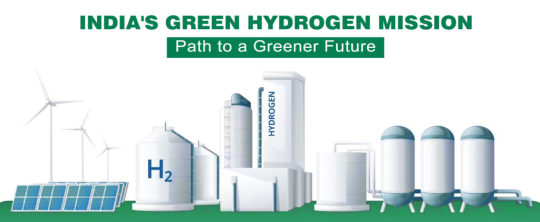
The Green Hydrogen Mission is a national initiative in India that aims to establish the country as a global hub for green hydrogen production, usage, and export. The mission involves promoting research and development in green hydrogen technologies, building necessary infrastructure, and creating a supportive policy and regulatory environment for the growth of the green hydrogen industry. The mission is a part of India’s strategic transition towards a sustainable and greener future.
What is Green Hydrogen?
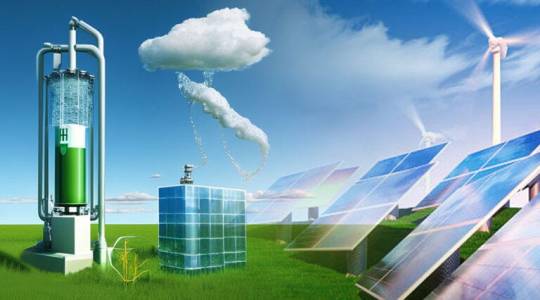
Green hydrogen is hydrogen gas produced through renewable energy sources like solar, wind, or hydropower using a process called electrolysis. Electrolysis involves passing an electric current through water, causing the water molecules to separate into hydrogen and oxygen. This carbon-free method distinguishes green hydrogen from grey and blue hydrogen, which are derived from fossil fuels. Grey hydrogen is produced from natural gas without carbon capture and storage (CCS) technology, while blue hydrogen uses CCS to reduce carbon emissions. As a sustainable and environmentally friendly alternative to traditional fossil fuels, green hydrogen is expected to play a significant role in future energy systems.
How Green Hydrogen Works?
Producing green hydrogen requires electrolyzers powered by renewable energy sources. These devices use electricity to split water molecules into hydrogen and oxygen while capturing the hydrogen. Green hydrogen can be stored in high-pressure tanks, metal hydrides, or liquid organic hydrogen carriers (LOHCs), which enable safe and efficient storage.
Transportation of green hydrogen primarily relies on pipelines, trucks, and ships, with ongoing research into new methods to improve efficiency, reduce costs, and minimize environmental impacts.
The Future of Green Hydrogen

Green hydrogen holds substantial potential as a clean and sustainable energy source, with applications spanning from fuel for transportation to power generation and industrial processes.
As a crucial component in the global energy transition, green hydrogen aims to reduce greenhouse gas emissions and decrease dependence on fossil fuels. However, its widespread adoption depends on addressing challenges in production, storage, and transportation, alongside ensuring economic viability.
With technological advancements and an increasing focus on renewable energy sources, green hydrogen is expected to play a more significant role in the future. Experts predict that green hydrogen could supply up to 25% of the world’s energy needs by 2050, paving the way for a cleaner and more sustainable future. Additionally, green hydrogen can help countries achieve their climate targets under the Paris Agreement, further emphasizing its importance in the global fight against climate change.
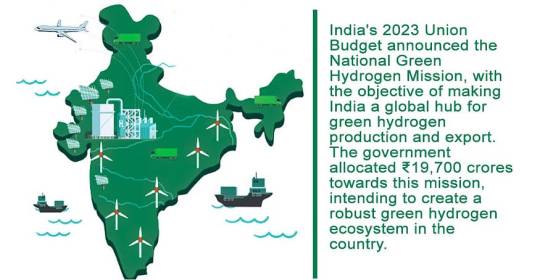
The mission focuses on research, development, and large-scale adoption of green hydrogen, aiming to harness India’s vast renewable energy potential and support the nation’s energy transition.
Key players in India’s green hydrogen industry include Larsen & Toubro, Tata Power, and Indian Oil Corporation, among others. These companies are investing in research and development, production facilities, and partnerships to strengthen India’s position in the global green hydrogen market. The mission also encourages the development of domestic manufacturing capabilities for electrolyzers, helping to boost local industries and create employment opportunities.
Applications of Green Hydrogen
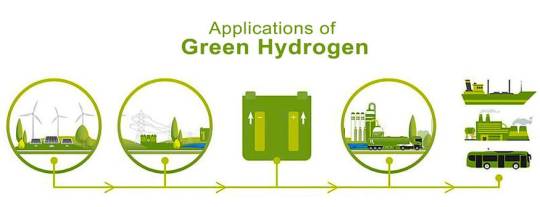
The versatility of green hydrogen makes it an attractive energy solution for various sectors. Some of its primary applications include:
Transportation: Green hydrogen can be used as a clean fuel in fuel cell electric vehicles (FCEVs), including cars, buses, and heavy-duty trucks. FCEVs generate electricity from hydrogen through a chemical reaction with oxygen, producing water vapour as the only emission. This makes them a promising alternative to traditional internal combustion engine vehicles, reducing greenhouse gas emissions and air pollution.
Aviation and Maritime: The aviation and maritime industries are exploring green hydrogen and its derivatives, such as ammonia and methanol, as alternative fuels. These industries face unique challenges in reducing emissions due to the energy density requirements of long-distance travel. Green hydrogen and its derivatives can help them achieve their sustainability goals and contribute to global efforts to combat climate change.
Power Generation: Green hydrogen can complement intermittent renewable energy sources like solar and wind by providing stable and reliable power during periods of low generation. When the energy demand is higher than the available renewable energy supply, green hydrogen can be converted back into electricity through fuel cells or gas turbines. This enables efficient energy storage and utilization, promoting the integration of renewable energy into the grid.
Industrial Processes: Green hydrogen can be used as a feedstock in energy-intensive industries, such as steel and cement production. By replacing fossil fuels with green hydrogen, these industries can reduce their carbon footprint and contribute to global emissions reduction targets. Green hydrogen can also serve as a feedstock for producing ammonia, methanol, and other chemicals, fostering a greener chemical industry.
Challenges and Opportunities in Green Hydrogen
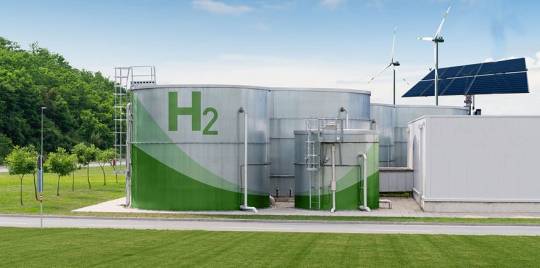
Despite its immense potential, the green hydrogen industry faces several challenges that must be addressed to ensure its widespread adoption and success. Some of these challenges include:
Production Costs: Currently, green hydrogen production costs are relatively high compared to traditional fossil fuels like petrol and diesel. The costs are more than 4–5 times higher. The cost of electrolyzers, renewable energy infrastructure, and other components required for green hydrogen production contributes to its higher price. To overcome this challenge, investments in research and development are needed to improve production technologies and reduce costs.
Storage and Transportation: Storing and transporting green hydrogen presents unique challenges due to its low energy density and the need for high-pressure or cryogenic storage systems. Ongoing research in storage technologies, such as metal hydrides and LOHCs, aims to address these challenges and develop more efficient, cost-effective solutions.
Infrastructure Development: The widespread adoption of green hydrogen requires the development of extensive infrastructure, including production facilities, pipelines, refuelling stations, and more. Governments and private investors must collaborate to fund and construct the necessary infrastructure, creating an environment that supports the growth of the green hydrogen industry.
Policy and Regulation: As a young industry, green hydrogen requires supportive policies and regulations to encourage investment, research, and adoption. Governments must implement policies that incentivize green hydrogen production and use, such as tax breaks, subsidies, and carbon pricing, to accelerate the transition to a green hydrogen economy.
Despite these challenges, the green hydrogen industry presents numerous opportunities for growth and innovation. The potential to transform the energy sector, reduce greenhouse gas emissions, and contribute to a more sustainable future makes green hydrogen an attractive prospect for governments, businesses, and investors. By working together to address the challenges and capitalize on the opportunities, the world can create a thriving green hydrogen industry that benefits people, the economy, and the environment.
Requirements for the Success of India’s National Green Hydrogen Mission
Need for Public Awareness and Engagement
Green hydrogen offers a promising pathway to a cleaner and more sustainable energy future. By addressing the challenges and harnessing the opportunities, the world can realize the full potential of green hydrogen and make significant strides in combating climate change. Education, public awareness, and engagement are essential components of this journey, empowering individuals and communities to contribute to the global effort to build a greener, more prosperous future.
Need for Investment and Financing
The green hydrogen industry requires significant investments to achieve its potential. Governments, private investors, and financial institutions must come together to provide the necessary capital for green hydrogen projects, including research and development, infrastructure construction, and skills training.
Public-private partnerships can be an effective way to mobilize investments and share risks, making green hydrogen projects more attractive to investors. Additionally, governments can use financial instruments such as grants, loans, and guarantees to support green hydrogen initiatives.

Green hydrogen has the potential to revolutionize the global energy landscape by offering a…..
To read the full article: India’s Green Hydrogen Mission: Path to a Greener Future
#ai#gpt 4#fintech#banking#education#chatgpt#google#blockchain#jobs#india#sustainability#green hydrogen#ecofriendly
0 notes
Text
youtube
In this YouTube video, we'll discuss barriers that are preventing the government from meeting its goal of tripling clean electricity capacity. Prime Minister Narendra Modi's 'Green Dream' aims to transform India into a global leader in renewable energy production, reduce its carbon footprint, and improve air quality. However, recent challenges have threatened to derail this ambitious plan, leaving Modi's green dream at risk.
#india renewable#renewable energy#india renewable energy#renewable energy projects#green energy#renewable energy sources#green hydrogen#green hydrogen explained#Modi’s green dream at risk as Indian renewables#best renewable energy projects#clean energy#green hydrogen production#renewable energy news#pm modi#mint#Youtube
0 notes
Text
RISING TH RAJASTHAN: A New Era of Growth and Innovation

From December 9 to 11, 2024, Rajasthan witnessed an extraordinary event that set the stage for the state’s future in global investment and development — the Rising Rajasthan Global Investment Summit 2024. This prestigious summit, held at the JECC (Jaipur Exhibition & Convention Center), Jaipur, was graced by the presence of none other than Hon’ble Prime Minister Shri Narendra Modi, whose visionary leadership continues to steer the state and the nation towards unprecedented growth.
Under the banner of #आपणो_अग्रणी_राजस्थान (Our Leading Rajasthan), the summit focused on showcasing the immense potential of Rajasthan as a major player in India’s economic transformation, while also highlighting its cultural and tourism prominence on the global stage. With PM Modi’s support and participation, the event aimed to attract investors, entrepreneurs, and innovators to the state, paving the way for new opportunities, collaborations, and partnerships.
A Vision for Rajasthan’s Future
The Rising Rajasthan Global Investment Summit 2024 was not just another conference; it was a statement of intent — a declaration that Rajasthan is no longer merely a land of historical monuments, forts, and deserts. Rajasthan is now an emerging hub for business, investment, and innovation.
PM Modi, in his keynote address, spoke of Rajasthan’s significant role in India’s development story. He emphasized that the state is now well-positioned to be a leader in sectors such as renewable energy, manufacturing, infrastructure development, and tourism. Rajasthan, with its vast natural resources, skilled workforce, and progressive policies, is ready to embrace the future with open arms, welcoming both domestic and global investors.
The Prime Minister’s presence at the event underscored the government’s commitment to fostering a favorable environment for business and entrepreneurship in the state. Through his words, PM Modi assured investors of the stability, reliability, and growth potential of Rajasthan. He highlighted that the state’s future will be built on the pillars of innovation, sustainability, and inclusivity.
Key Themes of the Summit
The summit brought together industry leaders, government officials, and entrepreneurs to discuss key sectors that hold promise for Rajasthan’s future growth. Some of the core themes and discussions included:
Renewable Energy Leadership: Rajasthan is already a leader in India’s solar energy revolution. With its vast open spaces and abundant sunlight, the state is poised to become a global hub for renewable energy investments. The summit focused on attracting investments in solar, wind, and green hydrogen projects.
Infrastructure Development: With initiatives like the Delhi-Mumbai Industrial Corridor (DMIC), Rajasthan is focusing on becoming a logistics and manufacturing powerhouse. The summit discussed large-scale infrastructure projects, including smart cities, transportation, and industrial zones, that will drive economic growth in the region.
Tourism & Cultural Heritage: Known for its royal heritage, majestic forts, palaces, and vibrant culture, Rajasthan continues to be one of India’s top tourist destinations. The summit highlighted opportunities in eco-tourism, adventure tourism, and heritage conservation, ensuring that the state remains a major attraction for global tourists.
Agriculture and Agri-Tech: As one of the largest producers of grains, pulses, and spices in India, Rajasthan is also focused on enhancing its agricultural sector through innovation in technology. Discussions revolved around boosting agricultural productivity, introducing sustainable farming techniques, and promoting agri-tech solutions.
Skill Development and Employment: Rajasthan is investing heavily in skill development to equip its youth with the skills needed for the future economy. The summit discussed strategies for improving education, training, and employment opportunities for the state’s growing workforce.
A Call for Global Partnerships
One of the standout messages of the Rising Rajasthan Global Investment Summit 2024 was the call for collaboration and partnership. PM Modi highlighted that Rajasthan’s growth would not be possible without the involvement of global businesses and investors. The summit served as a platform for networking, forging partnerships, and opening doors to new possibilities. By creating an ecosystem that encourages innovation, research, and development, Rajasthan is becoming an ideal destination for businesses looking to expand their footprint in India and the larger Asian market.
Rajasthan’s government is committed to providing the right infrastructure, policies, and incentives to create a conducive environment for business. With a focus on ease of doing business, robust legal frameworks, and transparent governance, the state is positioning itself as one of the most investor-friendly regions in India.
The Future is Bright for Rajasthan
The Rising Rajasthan Global Investment Summit 2024 was a defining moment for the state’s journey towards economic transformation. With PM Modi’s strong endorsement, Rajasthan is set to rise as a symbol of growth, sustainability, and innovation. The summit not only focused on attracting investments but also highlighted the state’s potential as a dynamic and reliable partner for global businesses.
The summit’s theme, #आपणो_अग्रणी_राजस्थान (Our Leading Rajasthan), reflects the spirit of pride and determination that the people of Rajasthan share as they look towards a future full of opportunities. Whether in renewable energy, infrastructure, tourism, or agriculture, Rajasthan is ready to lead, inspire, and make its mark on the global map.
As the summit concluded, it was clear that Rajasthan’s growth trajectory is just beginning. The state is rising, and with the commitment of its government, the support of Prime Minister Modi, and the active involvement of investors and entrepreneurs, Rajasthan is set to become one of India’s leading states in terms of investment, development, and innovation.
The Rising Rajasthan Global Investment Summit 2024 was a resounding success that showcased the state’s ambitions, opportunities, and path forward. With PM Modi’s leadership and the strong vision of Rajasthan’s government, the state is ready to harness its full potential. The event was a reminder that Rajasthan is not just Rising — it is becoming Reliable, Refined, and ready for the future.
As Rajasthan continues to evolve and innovate, the world is watching. The state is now on the global stage, and it’s clear that Rajasthan is ready to lead — not just within India, but across the world.
3 notes
·
View notes
Text
Clean Energy Design and Manufacturing
Avalon the top-rated EMS companies in India renowned for their quality services, technical expertise, and customer satisfaction.
#electronics manufacturing services#electronic manufacturing services#electronic manufacturing services companies#electronics manufacturing services India#electronics manufacturing services chennai#top Ems companies in India#best Ems companies in India#EMS#industry#cleanenergy#manufacturing#quality#renewableenergy#technology
2 notes
·
View notes
Text

2023 / 36
Aperçu of the Week:
“Keep pushing!”
(Literally every Formula 1 team principal over radio)
Bad News of the Week:
"Opposition is crap" is what Franz Müntefering, the legendary party leader of the German Social Democrats, once said. He may be right. But that should in no way justify the fact that some opposition politicians limit their political positioning to just that: opposition. In other words, being against. Against everything the incumbent government does. Basically. But that is precisely what Friedrich Merz, head of the largest opposition party in the Bundestag, the conservative Christian Democratic Union (CDU), is doing.
As a reminder, Merz was fired by Angela Merkel at the time. He earned millions at Blackrock and thought he was in heaven - on his third attempt and after almost 20 years of political abstinence - when he finally became head of his oh-so-beloved party. But the 20 years have not been kind to him. Sometimes it seems as if he has been on another star. His catchphrase at beer tent speeches is "Kreuzberg is not Germany - you are Germany!" He is usually applauded for this.
You have to know that Kreuzberg is a district in Berlin that was very colorful for decades. Many peoples, many languages, many cultures, many religions. Beautiful, actually. But for Merz and people like him, the epitome of non-German. And then also woke - where you can order your cappuccino with almond milk, families can have two mothers or two fathers, and there's no one named Friedrich in kindergarten. So for a stick conservative, it's hell on earth. And for the political opponent (i.e. the Greens and everyone to the left of the CDU - in other words, everyone), the home of the ideologically lost.
Merz is wrong in two respects. For one thing, even Kreuzberg is gentrified these days. Investment bankers like him live in the barely affordable old buildings. And there are far more SUVs on the street than rickshaws. So the image of a parallel society outside the "usual norms" no longer holds water. On the other hand, we now live in the 21st century. In which "Who's afraid of the bogeyman?" is no longer played in the playgrounds and everyone knows that the vegetables at Tarek's or Giorgios' on the corner are better than those in the supermarket. So Merz has disqualified himself with his Kreuzberg bashing. Once again. My hope is that this will slowly get around to his clientele...
Good News of the Week:
At the latest when it became clear that China's head of state Xi Jinping would not be attending, the G20 summit in India looked like a flop. And then intermediate shades - such as whether the host would call itself Bharat instead of India - seemed to dominate. So a pure show event with pretty pictures for the evening news and political experts mainly analyzing what is not happening? No, far from it. India achieved many small breakthroughs and even three major ones that were not expected.
First, Prime Minister Narendra Modi and his Sherpas succeeded in issuing an official final declaration that was supported by all 20 states. Which seemed unlikely with Russia and the U.S. at one table. Even if the Russian war of aggression against Ukraine is not mentioned by name, the use of brutal force is condemned. An "impressive diplomatic achievement," as Die Tagesschau writes. "The host saved a presidency that was threatened with failure."
Then a gigantic infrastructure project was launched that clearly positions itself against China's "New Silk Road." At this point, at the latest, Jinping might have regretted not coming. India, the Middle East - including Israel! - and Europe are to be better connected with the help of the United States - with rail tracks, hydrogen pipelines and power lines for renewable energies. Apparently a plan to be taken seriously. Because Italy's Prime Minister Giorgia Meloni immediately took the opportunity to announce in New Delhi that her country (the only participant so far from the European Union) was withdrawing from the partnership program with China.
And finally, the G20 effectively became the G21. For the "African Union" was welcomed as a new member on the very first day. The maltreated continent is thus given a voice at the table where the fate of humanity is decided. The bottom line is that one thing is also clear after this summit: there are more and more significant players whose self-confidence is growing. The world is becoming more multipolar. And that is a good thing.
Personal happy moment of the week:
Last week I was having a lot of happy moments. Bavarian moments with a Canadian guest to be precise. It's always nice to be able to introduce someone to your region, culture, cuisine, language, country, city, etc. If this is well received and appreciated, you are happy that you are privileged to live here. And even things that are commonplace for you start to shine again. Bella Bavaria!
I couldn't care less...
...that the Kremlin's United Russia party was declared the winner in sham elections in the Russian-occupied territories of eastern Ukraine. Key word of this statement: sham elections.
As I write this...
...everything in Germany revolves around the ball. First, on Sunday, the German men's basketball team won the world championship in Manila in a complete surprise - yes, (also) against the USA. And my second home country Canada won the bronze medal - yes, against the USA. Then the German soccer federation fired national coach Hansi Flick for losing a test match against Japan on Saturday in a crash. After he got knocked out in the preliminary round against Japan at last year's World Cup and hadn't improved at all since. If Germany were not hosting the European Soccer Championship next year, they would even have to fear for qualification.
Post Scriptum
Germany's society is aging. That's why we need a good half million immigrants every year, even if some on the political right don't want to acknowledge that. However, we are facing international competition. In which we are doing anything but well. I just read a series of interviews in which expats tell why they gave Germany a chance (leading technology companies, public safety, moderate climate) but then left again (excessive bureaucracy, difficult language, lack of a welcoming culture). As long as no one at least speaks English at the foreigners' authorities, landlords bluntly prefer "Bio-Germans", foreign educational qualifications are not recognized and little Fatima is looked at askance in kindergarten, there will be no preservation of our prosperity.
#thoughts#aperçu#good news#bad news#news of the week#happy moments#politics#formula 1#opposition#cdu#friedrich merz#kreuzberg#g20#India#USA#bavaria#canada#ukraine#germany#basketball#soccer#migration#championship#silk road#elections#xi jinping#China#wokeness#pushing#kindergarten
2 notes
·
View notes